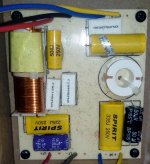Hello,
I have a pair of bookshelf Wharfedales Diamond 122 speakers, they sound nice but subdued in high frequencies, it's like they need 2 to 3 notches up in the tone control. Do you think this actions would help?
-Lowering the tweeter resistor value...maybe in half from 3.9 to 2 ohms?
-Changing what I believe to be polyester caps to polypropylene ones
FWIW the cap close to the 3.9 resistor with the "DIA 122" sticker is 4.7uf... I'm about to order caps to make new crossovers for Kef Kit3 Concertos and was thinking to include some caps for the Wharfedales to the order
Thanks
I have a pair of bookshelf Wharfedales Diamond 122 speakers, they sound nice but subdued in high frequencies, it's like they need 2 to 3 notches up in the tone control. Do you think this actions would help?
-Lowering the tweeter resistor value...maybe in half from 3.9 to 2 ohms?
-Changing what I believe to be polyester caps to polypropylene ones
FWIW the cap close to the 3.9 resistor with the "DIA 122" sticker is 4.7uf... I'm about to order caps to make new crossovers for Kef Kit3 Concertos and was thinking to include some caps for the Wharfedales to the order
Thanks
Attachments
As far as I can see there's no need to change the caps. If the speakers aren't bright enough then lowering the value of the resistor will be your best bet at a quick fix and easy to undo too.
Thanks
I'm really not sure whether these caps are MKTs or MKPs... anyway I guess the difference won't be that much.
Anybody knows if 504J stands for 0,5uf?
I'm really not sure whether these caps are MKTs or MKPs... anyway I guess the difference won't be that much.
Anybody knows if 504J stands for 0,5uf?
I wouldn't fiddle with any of those capacitors as they are all perfectly up to the job.
A quick way to gauge how much the resistor is affecting the tweeter level is to short it out with a length of wire.
Then take it from there!
A quick way to gauge how much the resistor is affecting the tweeter level is to short it out with a length of wire.
Then take it from there!
Last edited:
You are correct.
j is 5% tolerance
value is in pFarads. The first two numbers are the values and the next digit is the multiplier.
You have 50 x 10000 = 500000pF =500nF =0.5uF
j is 5% tolerance
value is in pFarads. The first two numbers are the values and the next digit is the multiplier.
You have 50 x 10000 = 500000pF =500nF =0.5uF
In stages:
504J
50 x 10^4 pF
500 nF
0.5 uF
https://www.synthrotek.com/wp-content/uploads/2012/08/Capacitor-Codes.pdf
504J
50 x 10^4 pF
500 nF
0.5 uF
https://www.synthrotek.com/wp-content/uploads/2012/08/Capacitor-Codes.pdf
a bypass cap (cap in parallel) of a small value with the series resistor to the tweeter - only if the series resistor is immediately before the tweeter, will allow high frequencies to bypass the resistor. You could try 2.2uF. lower values will lower the frequency of the bypass (i.e. if not bright enough, increase cap value)
- Home
- Loudspeakers
- Multi-Way
- Brighten up Wharfedale 122 Diamonds (crossover)
